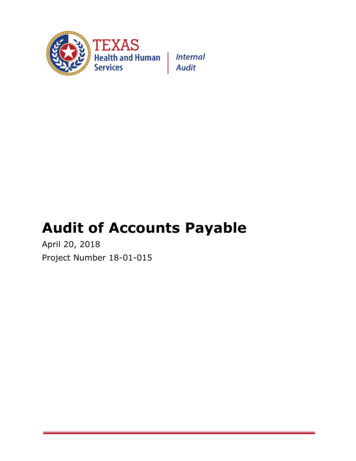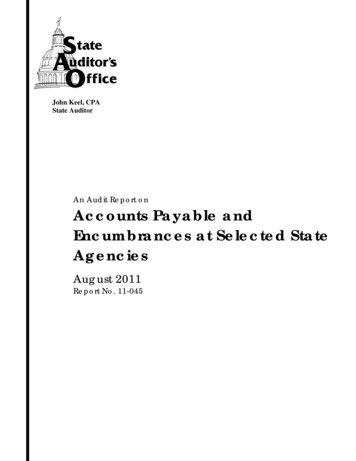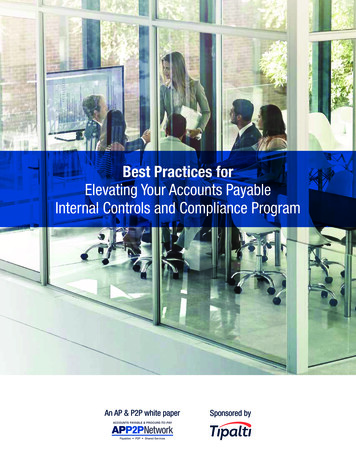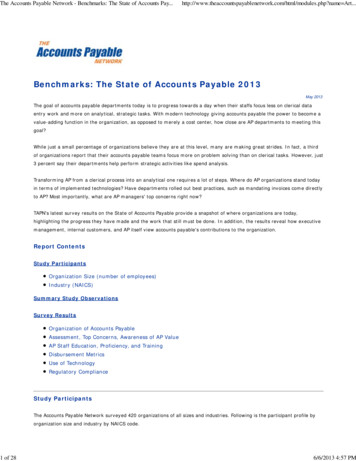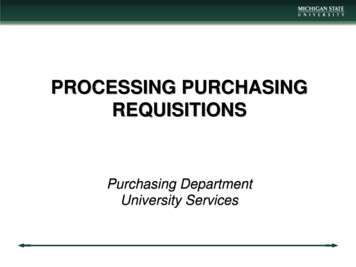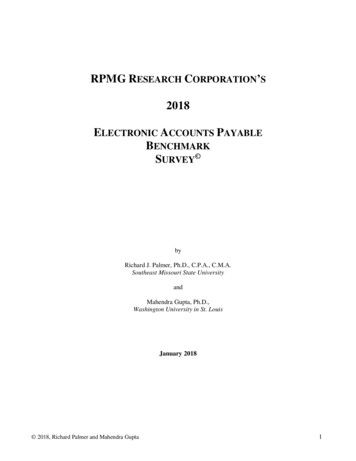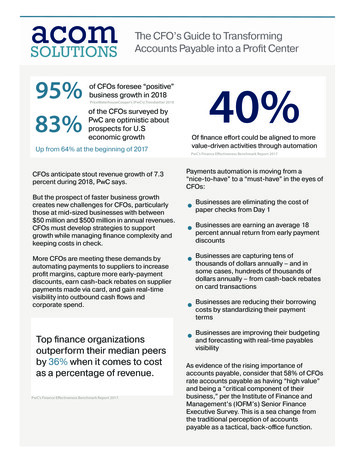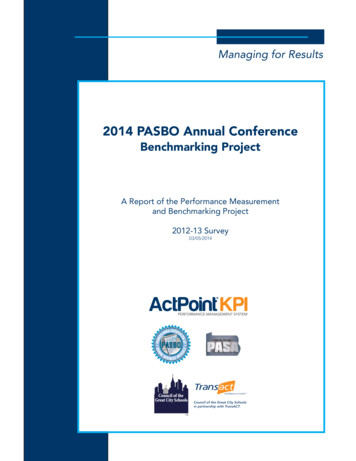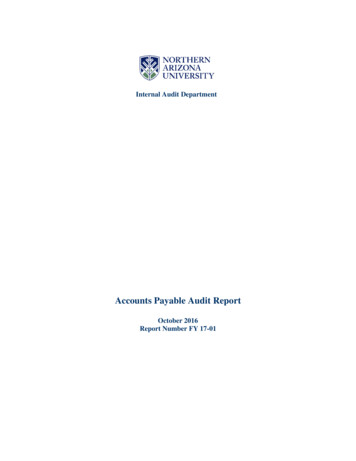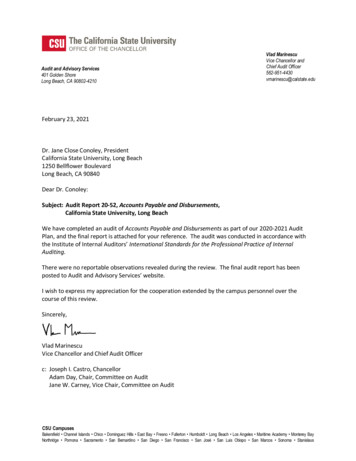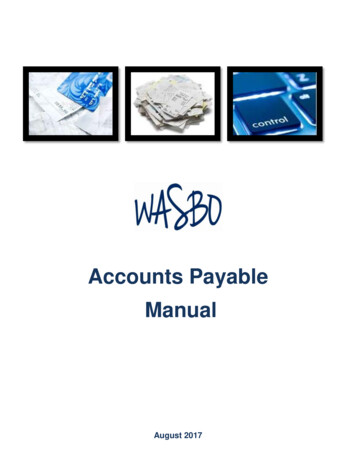
Transcription
Accounts PayableManualAugust 2017
Page 2Table of ContentsIntroduction. 3Accounts Payable. 4Vendor Payments . 6Paperless Invoice Process . 12Imprest Accounts and Petty Cash Funds . 14Charge Cards and Procurement Cards . 16Employee Travel and Expense Claims . 18Expense Claims for Reimbursable Items . 19Daily Travel and Mileage. 20Expense Claims for Meals (while not in overnight travel status) . 21Overnight Travel . 22Travel Advances and Travel Charge Cards . 25Refunds of Revenue . 26From Invoice to Payment . 27Warrant Certification and Approval. 29Warrants, Wire Transfers, and Other Payment Methods . 32Warrant Voids, Cancellations, and Duplicate Instruments. 34Sales Tax . 37Use Tax. 39Federal Excise Tax Exemption . 40Public Works and Retainage . 41Internal Controls . 44Independent Contractor versus Employee . 46IRS 1099 Reporting . 50Unclaimed Property . 53The Accounting and Budgeting Connection . 56Inventories and Prepaid Items. 59Year End Expenditure Accruals . 60Resources/References . 62WASBO Accounts Payable Manual, August 2017
Page 3IntroductionThe purpose of the WASBO Accounts Payable Manual is to provide a resource for the unique functions ofschool accounts payable. The manual draws together in one publication all matters associated with accountspayable including the best practices from both large and small school districts. Information has been gatheredfrom RCW, WAC, the Accounting Manual for Public School Districts in the State of Washington, InternalRevenue Service publications, state agencies such as Department of Revenue, Department of Labor andIndustries, and many other sources.The WASBO Accounts Payable Manual should not be considered a step-by-step process and it should not beconsidered a substitute for legal counsel. Each district must consider their unique circumstances and prioritiesbefore adopting the recommendations, tips, and best practices suggested in the manual. Accounts payableprofessionals are encouraged to review their district policies and procedures related to accounts payable.Although accounts payable functions closely relate to purchasing functions, this manual does not attempt toduplicate the information provided in the WASBO Purchasing and Warehouse Handbook. The WASBOPurchasing and Warehouse Handbook should be considered a companion to the WASBO Accounts PayableManual. This publication focuses on the accounts payable functions.The WASBO Accounts Payable Manual was developed by Denise Wolff and Cory Plager of the WASBOAccounting and Budgeting Committee. Special thanks to Holly Burlingame, CSBA, who was instrumental incompiling and preparing this publication. Thanks also to DeAnn Wagoner for her editing skills. It is the intentof the WASBO Accounting and Budgeting Committee to update this manual periodically as needed.This publication may be reproduced as needed within your school district. Any additional information orconcerns you may have in regard to this manual can be sent in writing to the WASBO office either by mail or email.By Mail:WASBOAttn: The Accounting and Budgeting Committee284 Lee Street SW, Suite 132Tumwater, WA 98501By E-Mail:admin@wasbo.orgWASBO Accounts Payable Manual, August 2017
Page 4Accounts PayableAccounts payable functions include the payment of all vendor invoices, employee reimbursements (other thanpayroll), and imprest account reimbursements in a complete, accurate, and timely manner. In a medium tolarge district, the accounts payable process may be handled by an entire department of accounts payabletechnicians. In a small district, this might be only one function of a single individual’s many job duties.In either case, the purpose of the accounts payable function is to ensure that all disbursements of schooldistrict funds are done in accordance with: the internal control procedures set by district managementthe accounting practices of the districtthe account code structure of the district and the statestate lawfederal requirementsgood business practiceThe traditional purchase to pay cycle can best be illustrated as follows:The accounts payable function plays a key role in the support of the school district. An Accounts PayableDepartment has independent, segregated responsibility for paying invoices initiated by district budgetmanagers, invoiced by vendors, and approved by the board of directors. The department provides customerservice to both district users and vendors. Budget managers rely on the department to ensure accurateexpenditure and encumbrance reporting and assistance with questions. Vendors rely on the Accounts PayableDepartment to pay their invoices, reconcile their statements, and answer related questions. Districtadministrators and board members rely on accounts payable for accurate external financial reporting,preventing audit issues, and maintaining good relations with vendors and staff.The accounts payable functions of a school district are closely tied to the purchasing functions. In small schooldistricts, these two functions may be handled by the same individual. Larger districts typically have aWASBO Accounts Payable Manual, August 2017
Page 5Purchasing Department which is separate from an Accounts Payable Department. In either case, having anunderstanding of the purchasing requirements is helpful when providing accounts payable services.Purchasing is responsible for assuring that the district gets the best products and services at the lowest cost.Other important purchasing functions include approving purchase orders, preparing and awarding bids,initiating personal services contracts, monitoring federal purchasing requirements, acting as primary contactwith vendors, approving new vendors, maintaining the vendor database, and managing the district’spurchasing card program. The WASBO Purchasing and Warehouse Handbook is one good source ofinformation on purchasing functions.WASBO Accounts Payable Manual, August 2017
Page 6Vendor PaymentsA vendor is a legally registered business preapproved by the district’s purchasing department. A contractor isalso a vendor of the district. Vendors must be registered with the IRS and have a tax identification number(TIN) which can be either an employee identification number (EIN) or social security number (SSN).Additionally, contractors must be registered in the State of Washington and have a Uniformed BusinessIdentifier (UBI) number. Employees of the district cannot be vendors of the district unless they have aregistered business which is substantially different from the services they perform as an employee. There alsomay be vendors who actually qualify as employees. See the section on Employee vs. Contractor for furtherdetails.New VendorsThe Purchasing Department should be in control of approving and entering new vendors into the accountingsystem. The Accounts Payable Department, which is responsible for issuing vendor payments, should not alsobe able to set up new vendors. This is a key internal control over disbursements. If the district is not largeenough to have new vendor set up and vendor payment segregated, other compensating controls must be putin place to assure internal control of vendor disbursement.Each district should develop written procedures for entering new vendors into the data base. A requirement fornew vendors and contractors to complete an IRS form W9 or substitute W9 form is a good internal control,especially for districts without segregation between new vendor set up and payment. This form is used togather key information such as legal vendor name, EIN/SSN number, and UBI number. It is also helpful ingathering required 1099 reporting information.Each vendor should be issued a vendor number in the district’s vendor database. Only one vendor numbershould exist for a vendor. The vendor number will assure accuracy of vendor name and address,accumulation of 1099 information, accumulation of vendor payments for bid limit testing, and prevention ofinvalid vendors.Tip: Requests for new vendors can be controlled by using the district’s purchasing software. When apurchase requisition is issued at a school or department to a new vendor, software should enable therequisitioner to select “new vendor” and provide the vendor name and address in a notes field. This will enablethe Purchasing Department to double check for an already existing vendor number or begin the process ofsetting up a new vendor.Vendor InvoicesVendor invoices are the source document for accounts payable transactions. In no case should a districtcreate its own accounts payable invoice. Invoices are received from vendors in various formats. Acceptabletoday are electronic invoices, faxed invoices, and original invoices. In the absence of clearly identified originalinvoices, the district must have a system to control duplication of invoice payment, such as software systemcontrols over duplicate invoice numbers by vendor ID. To prevent duplication, it is important that accountspayable technicians enter vendor invoice numbers exactly as they appear on the invoice including leadingzeros and dashes. Only one vendor number for any vendor should exist in the vendor database.Invoices should be mailed directly to the Accounts Payable Department to avoid the possibility of beingoverlooked. It is recommended that all purchase orders give vendors clear instruction on where to send theirinvoices.WASBO Accounts Payable Manual, August 2017
Page 7Invoices should be matched to the district’s vendor database, verification of receipt of goods and services, andpurchase orders. The process of matching is often referred to as the three-way match.There are circumstances when the district will pay an invoice without a purchase order. Examples of this areutility costs which are invoiced regardless of an order being placed. These are referred to as direct paymentsin this document. Other exceptions to purchase orders and the three-way match will be discussed in detaillater in this section.Purchase OrdersSchool districts often use purchase orders to initiate a purchase from a vendor. Purchase orders are used to: Complete an approval process prior to the buy.Communicate the order to the vendor.Establish a contract with a vendor.Encumber the amount of the purchase against a budget.Track receipt of goods and services.Provide information for accounts payable when auditing invoices.Accumulate expenditure/payment information.Ideally, vendor invoices will reference the district purchase order number. If no purchase order is indicated, theaccounts payable technician may have to search the purchase order database using vendor, items purchased,and ship-to locations to find the purchase order.Verifying Invoice to Purchase OrderAccounts payable technicians should verify that the items invoiced match the items ordered on the purchaseorder. Consider the following when matching the items Does the vendor information on the invoice match the vendor information on the purchase order? Was the invoice issued prior to the purchase order being approved? All purchase orders should beissued prior to invoices being received. Are the items invoiced the same as the items ordered? If paying on an open purchase order, do the items match the general category of items authorized? Do the amounts invoiced (by total or by item) match the purchase order? District practice may allow acertain percentage variance between the purchase order amount and the invoice amount. Does the invoice have enough detail to verify that the services were performed as contracted? Aninvoice for services, especially a progress invoice, should include details such as dates of service,description of services, and hours of service. Have all required documents been received (i.e., signed contracts, public works requirements, etc.)?Verifying Invoice to Receiving DocumentDistrict procedures may require the use of electronic verification of receipt through the district’s accountingsystem or paper documentation such as signed packing slips or other receiving forms. In the case of itemsordered on a purchase order, the purchase order is the approval to pay. The receiving of items can be verifiedby any responsible employee such as a warehouse person or office manager. The receiving of contractedservices will require verification by a person with knowledge of the services being performed. Consider thefollowing when verifying invoices to receiving documents: Does the invoice match the items received? When were the items received? This will make a difference at year end when determining the fiscalyear. Is the order complete and can the purchase order be finalized?WASBO Accounts Payable Manual, August 2017
Page 8Paperless receiving - It is recommended that districts require on-line receiving. On-line receiving isavailable in most software and provides increased visibility to receiving and approval verification. It eliminatespaper routing and storage of packing lists.Accounts payable vendor invoice audits should include: Verify that the three-way match has been completed: purchase order, receiving, and invoice (seeexceptions below). Verify that the invoice is not a duplicate. Use exact vendor invoice number, amount, and date to verify. Total invoice amount is correct. Shipping and handling have been applied correctly per the purchase order. Sales tax rate is correct for the delivery location (see sales tax section for complete details). Use tax is added for out-of-state vendors or when Washington vendors have not charged sales tax asrequired. Is this a public works invoice requiring retainage to be held (see Public Works section for completedetails)? All charges are current and the invoice does not include a brought-forward amount. Purchase order encumbrance is sufficient to cover the current invoice or is within the district’s variancetolerance. Verify that the invoice pricing matches any quote or bid pertaining to the purchase order. Verify the account code is correct per the district’s chart-of-accounts, department responsibility, andstate account code requirements for program, activity, and object. Determine the fiscal year for processing (see year-end accrual section for further details).Exceptions/alternatives to the three-way matchThere are several exceptions or alternatives to the standard three-way match (purchase order, receiving,invoice) for paying vendor invoices, these include: Direct payments where no purchase order was issued.Prepayments for services not yet received.Purchasing card and credit card transactions.Imprest and petty cash transactions.Direct payments are payments made without a formal purchase order being issued. One common use ofdirect payments is utility services which are invoiced regardless of a purchase order being authorized. Somedistricts may also allow for purchases below a certain amount to be placed without a purchase order. Fordirect payments the accounts payable technician will match a vendor invoice to an authorization to pay. Thedistrict should have clear policy on when direct payments may be made and the payment authorizationrequirements.Prepayments are payments made in advance of receiving the goods or services. Typical examples arereservations and deposits. A deposit may be required when a district rents an event facility. A registration feemay be required in advance of a student sports competition event. Prepaying for items should be an exceptionused only in specific circumstances authorized in the district’s policy. For prepayments the Accounts PayableDepartment will need a source document for payment. This source document might be the vendor’s facilityrental agreement or the sporting event registration form. In no case should the district create its own paymentsource document. Accounts payable should match the source document to the authorization to pay. Theauthorization to pay may be in the form of an approved purchase order.WASBO Accounts Payable Manual, August 2017
Page 9Purchasing card, credit card, imprest, and pretty cash transactions are discussed in detail in later sections ofthis manual.Prompt PaymentGood business practice requires that all vendors be paid within 30 days of receipt of the invoice. This iscontingent, of course, on the district receiving the goods and services. If the district is not able to pay within 30days, they risk losing credibility with vendors who may also be taxpayers in the district. It is also important fordistrict budget managers to have current expenditure information on their financial reports. There are a fewvendors who still provide discounts for paying quickly and the district may want to take advantage of thosediscounts. There are several factors that may prevent timely payment including lack of receipt verification fromthe requisitioner or missing the board approval cycle.Vendors may provide early settlement discounts if their invoices are paid prior to the due date. Here is anexample of discount terms:2/10, net 30Vendor will allow a 2% discount for invoices paid within 10 days of the date of theinvoice (not the receipt of the invoice). Day means calendar day including weekendsand holidays. Calculate the discount on the total invoice, after tax, and deduct from theinvoice payment amount.Taking an early settlement discount is not always economically sound. It is sometimes more economical for adistrict to hold onto their money and pay within 30 days. The U.S. Treasury has an easy calculator that willdetermine, based on the current value of funds rate (what your money is worth), whether the discount isadvantageous to take. This tool is available at http://fms.treas.gov/prompt/discount.html. The following is anexample of an invoice dated five days ago that offers a 2% discount if paid within the next 5 days (2/10, net30). The tool confirms that the discount is economically advantages and may be taken.WASBO Accounts Payable Manual, August 2017
P a g e 10Late PaymentsThere are many factors that may prevent a district from paying within 30 days. These include lack of receiptverification, missing the school board approval cycle, invoices not mailed directly to accounts payable, andworkload issues. In no case should the vendor be paid late because the items are for the next fiscal year.If the district pays after the invoice due date, the district may be charged late fees by the vendor. Schooldistricts should never pay more than twelve percent annual interest, or one percent monthly, on late fees. Thisis the maximum allowed under RCW 39.76.011 (1). If the vendor has invoiced the district for late fees, checkthe calculation of those late fees based on the number of days paid after the invoice was due (usually 30 days)and the maximum allowable interest of one percent monthly. The U.S. Treasury also has a prompt paymentcalculator on their website that will quickly calculate the amount owed in late fees. Be sure to always use onepercent interest per Washington State law.http://fms.treas.gov/prompt/ppcalc1.htmlWASBO Accounts Payable Manual, August 2017
P a g e 11Correcting Vendor InvoicesAn invoice may be determined to be incorrect for many reasons. It is not recommended that the district correctvendor invoices, but rather return them to the vendor for correction. This allows the vendor’s records to becorrected and saves confusion when the district’s payment is received. Invoices requiring vendor correctionshould be returned promptly (7 days is suggested). Any discounts or late fees should be based on thecorrected invoice.Vendor CreditsThere are times when vendors are overpaid or items are returned and a credit is due to the district. Vendorsmay issue a credit invoice. Accounts payable should enter these credits into the computer system as soon aspossible using the expenditure account code from the original invoice. When the district has invoices due tothe vendor for more than the credit, the credit can be taken. For example, the district has received a credit forreturned items from ABC Office Supply in the amount of 320.00. Accounts payable has entered two otherABC Office Supply invoices in the amount of 125.00 and 75.00. Accounts payable should enter theseinvoices applying them to the appropriate account codes. ABC Office Supply still owes the district 120.00 andno payment will be processed.Credit Return CR 1235, 4/14/xxInvoice 7755, 4/30/xxInvoice 7759, 5/5/xxAmount still due to districtDistrict Account530.01.27.5530.97.13.5530.97.12.5 (320.00)75.00125.00 (120.00)The district should request the vendor pay the credit by check if it is unlikely there will be sufficient invoices toapply the credit against. If the district receives a cash refund for a vendor credit, the cash receipt should beapplied to an expenditure account used on the original invoice.WASBO Accounts Payable Manual, August 2017
P a g e 12Paperless Invoice ProcessPaperless processing and storage of accounts payable invoices can reduce the cost of payments and improveaccess to disbursement records. In a paperless system, accounts payable technicians work with imagesrather than hard copies to process payment. Images can be sent to requisitioners for approval and receivingverification; can be viewed as attachments to financial reports; and can substitute for paper documentation forrecords retention.In order to qualify to scan and toss original invoices, the district must adhere to the standards for imaging set instatute (WAC 434-633). These standards were developed by the Secretary of State Archives Division withassistance and input from the State Auditor’s Office. The Secretary of State Archives Division has provided aself-authorization questionnaire, “Requirements for Destruction of Non-Archival Paper Records after Imaging.”It is important when completing the questionnaire that districts understand the requirements in order to get acomplete and accurate capture and applied indexing or other organization to those images. The questionnairecan be found on the Secretary of State’s website under records management, local governments, Scanningand Tossing at http://www.sos.wa.gov/archives/In a paperless accounts payable process, vendors are encouraged to submit electronic invoices to the district’sAccounts Payable Department. Vendors may either email electronic invoices to districts or provide access totheir websites so districts can download electronic invoices. Providing vendors with a generic accountspayable email address will help the district manage email invoice receiving.Invoices that are mailed by vendors are scanned immediately and the originals destroyed. The district shoulddevelop a process to temporarily store original invoices until a good image is verified within the softwareapplication.Here is an example of how this process might be set up:1.2.3.4.5.6.Invoice is received in the mail.Accounts payable technician scans the invoice using a desktop scanner.Image is named and filed on the hard drive or server.Image is routed to the user for payment verification.Receiving is verified electronically.Accounts payable technician views the image on one computer monitor and enters the invoice data(amount due, invoice number, invoice date, etc.) into the fiscal software using a second computermonitor. Some software allows for optical character recognition (OCR) that reads images and partiallycompletes accounts payable data entry.7. The scanned invoice image is then attached to the accounts payable transaction within the district’ssoftware.8. The invoice image is viewed by drilling down of the transaction amount on fiscal reports.The specific steps that are eliminated are: Managing unmatched invoices by pile (or tickler file).Stapling invoices to voucher covers.Filing paper vouchers.Accessing paper files to retrieve payment data.The equipment needed for paperless invoice processing includes a high speed scanner, imaging software(often provided with the scanner), and a second monitor for easy viewing.WASBO Accounts Payable Manual, August 2017
P a g e 13The scanned images of invoices serve as the source document and must be kept for the state requiredretention period.The State Auditor’s Office will accept scanned invoices during disbursement audits.For more information contact the Washington State Archives at recordsmanagement@secstate.wa.gov.WASBO Accounts Payable Manual, August 2017
P a g e 14Imprest Accounts and Petty Cash FundsImprest AccountsAn imprest account is a bank checking account for handling disbursements whereby a fixed amount of moneyis set aside for a specific purpose. The amounts expended from the account are restored so that it remainsintact.A district may have imprest checking accounts authorized for school ASB funds, Business Office revolvingaccounts, self-insured dental and vision funds, and advanced travel funds. The board of directors of the schooldistrict must authorize the amount by resolution. A custodian, such as an ASB bookkeeper, must be appointedover each imprest checking account.Accounts payable is responsible for replenishing the imprest checking account. A replenishment request willbe submitted by the custodian, preferably monthly, to the Accounts Payable Department for the total of allchecks written since the last replenishment. For example, a high school ASB has been issued a 3,000imprest checking account. During the month, the custodian of the account, the ASB bookkeeper, has issuedchecks 1001 through 1005 for a total of 2,100. Before the replenishment, the balance of the checkingaccount is 900. The Accounts Payable Department will issue a warrant for 2,100, restoring the balance ofthe checking account to 3,000 ( 900 2,100).Receipts must be attached for each imprest check written. The district should use a standard replenishmentrequest form.Replenishment request forms must include the following: Reconciliation of the total of the fund against the current replenishment request and the currentchecking account balance. Certification from the custodian th
Accounts payable functions include the payment of all vendor invoices, employee reimbursements (other than payroll), and imprest account reimbursements in a complete, accurate, and timely manner. In a medium to large district, the accounts payable process may be handled by an entire dep
